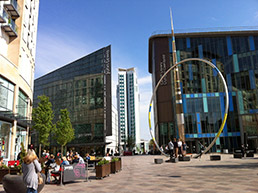Subscriber Benefit
As a subscriber you can listen to articles at work, in the car, or while you work out. Subscribe NowIn Welsh, “ddinas livable” means livable city. Cardiff, Wales, is a capital city for governance and sports that is at the center of a well-planned region. Cardiff is livable, international, ethnically and culturally diverse, and economically vibrant. It is the smallest and youngest European capital and it is a very ddinas livable.
Cardiff has 360,000 people packed around a walkable, historic city center. It has less than half the population and more than four times the density of Indianapolis. The national stadium dominates the city’s modest skyline. Like Indianapolis, it is a sports capital, but its sports are rugby, soccer and cricket. Its stadiums host professional and club teams.
This summer, I am supervising Cardiff University’s urban design graduate students. As with Ball State University’s graduate population, it is a diverse and international group. They bring a global perspective and are asking interesting questions regarding the future of cities.
 The Hayes has traditional historic and modern urban architecture that creates a vibrant central plaza for downtown Cardiff, the capital city of Wales. (Photo courtesy of Bruce Race)
The Hayes has traditional historic and modern urban architecture that creates a vibrant central plaza for downtown Cardiff, the capital city of Wales. (Photo courtesy of Bruce Race)Many of the students’ thesis projects are focused on urban issues facing their own communities. Their research reflects the universal experience of cities. They want to create safe and interesting public spaces and streets; design waterfront districts that are woven into their city; redesign brownfield sites as healthy neighborhoods; create youth- and family-friendly neighborhoods; leverage the value of transit access; and revitalize downtown districts. These are the same topics our students are pursuing in Indianapolis for cities in China, India, Greece, the Middle East, Thailand, Portugal and the UK.
Cities have universal functions and characteristics. Demographer Joel Kotkin defines cities as places that are sacred, safe and busy. Historian Spiro Kostof identifies cities as energized and crowded places that have physical circumstances and resources, such as rivers, influencing their placement. Cities have a “physical monumental framework.”
Indianapolis certainly meets Kotkin’s and Kostof’s universal definitions of a city. However, we often do not acknowledge the importance of these necessary universal elements of great cities. Some are under our control, such as reinforcing and celebrating what is left of our fantastic “monumental framework.” Others are more difficult to manage, such as working toward a well-planned, mobile and economically connected region.
A good professor is always a student. There are four lessons to be learned from Cardiff.
• Historic preservation and contemporary architecture.
There is something inspiring about a place that honors its past with contemporary architecture that is urbane and contextual. Cardiff has Roman ruins, Medieval castles, the great Norman Llandaff Cathedral, and beautiful turn-of-the-century commercial structures and neighborhoods.
Most buildings are from Cardiff’s period as the busiest port in the world due to the export of coal. New buildings are designed to inspire and still fit into a city that feels Old World and modern at the same time.
• Active streets.
The density and quality of street retailing is impressive. There are large contemporary malls and wonderful historic arcades. Somehow, their designs do not suck the life out of the streets. They embrace the streets rather than turning away from them.
City residents and visitors come together on The Hayes, Queens Street and St. Mary Street. They are sacred, safe and busy with churches, major shopping centers, storefront shops, restaurants and cafes.
• “Cynllun rhanbarthol” means regional plan in Welsh.
After World War II, the United Kingdom developed regional plans. The city’s relationship with the countryside is protected because regional planning preserved farmland and steered shopping and entertainment to the regional centers.
In Cardiff, this pattern is reinforced by a robust multimodal transportation system connected by a safe and comfortable walking environment. It is a great city to walk in. The towns that orbit the capital are great places to walk, too.
• Taking the long view—low-carbon cities.
The Welsh government and Cardiff residents make sustainable planning and lifestyle choices. There is a focus on energy-efficiency, and reducing greenhouse gas emissions.
Historically dependent on coal, Wales and Cardiff are innovators in the development of building and energy technologies that leverage their local universities’ expertise. Cardiff is a “dinas gynaliadwy”–a sustainable city.
Indianapolis and Cardiff have much in common. Both are capitals and both have made a commitment to amateur and professional sports. They have historic assets and are at the center of regional economies. Neighborhoods adjacent to downtown are undergoing a transformation energized by young people with a new entrepreneurial spirit. And both can be a learning laboratory for young visitors, not just urban design students.
Hoosier urbanism is on display for young athletes, FFA kids and others from across the country on a regular basis. They get to experience the heart of Indiana—the state capital and center of a region of over 2 million people. What four observations about cities are they taking home with them?
Young people around the world are moving to cities to benefit from their economic and social advantages. They are redefining the ddinas livable as a place that captures the past and expresses a hopeful future. I am listening and learning.•
__________
Bruce Race, FAIA, FAICP, is an award-winning architect and urban planner, owner of RACESTUDIO and recipient of the Indiana Sagamore Planning Award. He lives in a historic Indianapolis neighborhood and teaches urban design at Ball State University’s Downtown Indianapolis Center. His column appears monthly. He can be reached at br@racestudio.com.
Please enable JavaScript to view this content.
